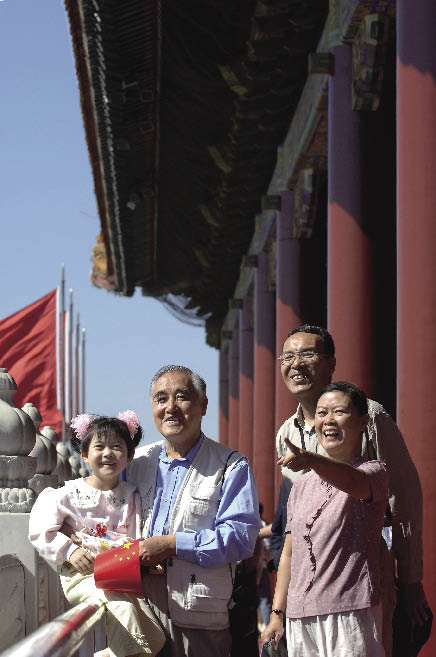| Doors Open on the Tian'anmen Rostrum
On January 1, 1988, the first day of "Beijing International Tourism Year," the 75-year-old retiree Gao Xiwu was the first Chinese tourist to ascend the Tian'anmen Rostrum, and a French couple became the first foreign tourists to do so. Tian'anmen Rostrum was being made accessible to ordinary citizens over 500 years after its construction, receiving more than 2,000 tourists on that first day.
 |
| Looking out from the Tian'anmen Rostrum is a right enjoyed by ordinary citizens. Cnsphoto |
Tian'anmen Gate was the principal entry to the Imperial Palace during the Ming and Qing dynasties spanning from the early 15th century to the early 20th century. When Chairman Mao Zedong announced the founding of the People's Republic of China on October 1, 1949 from the Tian'anmen Rostrum, the five-starred national flag was raised over Tian'anmen Square for the first time. However, following the founding ceremony of the PRC, the Tian'anmen Rostrum opened its doors only for important national events, such as receiving distinguished foreign guests.
In 1984, a letter from a person named Hua Xing caught the attention of national leaders, including Hu Yaobang, then general secretary of the Central Committee of the Communist Party of China (CPC). In the letter to the central authorities, Hua expressed his hope that he would be allowed to enter "the heart of the country," as the rostrum was proudly called. The central authorities responded by instructing the Beijing municipal government to work out a plan for opening it up.
On May 1, 1986, the Tian'anmen Rostrum began to receive groups of special visitors. They included participants in conferences held by the CPC Central Committee or armies stationed in Beijing, deputies to the National People's Congress, and model workers. Strict registration and approval procedures were in place for the visits. Then in 1988, the rostrum was officially opened to the public. The price for entry was RMB 10 for domestic visitors. It was not cheap, but more than 600,000 visits were recorded in 1988 alone. In 2008, 20 years after its opening, it had received over 40 million visitors.
The Tian'anmen Rostrum is the symbol of the nation. In the view of Yang Dengyan, who took part in preparatory work for the opening, "The unlocking of such an historic place, one so associated with Chinese leadership and power, proves that anything in China can be accessed by the people." The Tian'anmen Rostrum was revived against the larger backdrop of China's reform and opening-up, which accelerated dramatically in the following months. The number of open cities and counties increased to 288, affecting 160 million people in coastal areas.
|
